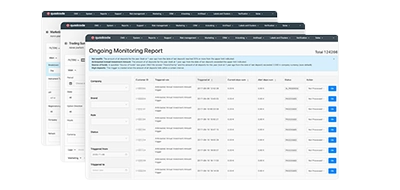กลับ
Contents
Liquidity Sweep: Everything You Need to Know สิ่งที่คุณต้องรู้เกี่ยวกับ Liquidity Sweep


Vitaly Makarenko
Chief Commercial Officer

Demetris Makrides
Senior Business Development Manager
ข้อสรุปที่สำคัญ
- การสวิงสภาพคล่องคือการซื้อขายขนาดใหญ่เชิงกลยุทธ์ที่ออกแบบมาเพื่อตั้งค่าให้คำสั่งหยุดที่กลุ่มและตำแหน่งที่ค้างอยู่ถูกเรียกใช้งาน
- พวกมันมักเกิดขึ้นที่จุดสูง/ต่ำของการสวิง ระดับแนวรับและแนวต้าน และจุดฟีโบนักชีที่มีกลุ่มของสภาพคล่องสะสมอยู่
- เทรดเดอร์ใช้การเคลื่อนที่ของสภาพคล่องเพื่อยืนยันทิศทางของแนวโน้ม, จับการกลับตัว, หรือทำกำไรจากการล่า Stop ของนักลงทุนสถาบัน.
- เพื่อเพิ่มความแม่นยำ ควรรวมการวิเคราะห์การสแกนสภาพคล่องเข้ากับโครงสร้างตลาด กระแสคำสั่ง และข้อมูลปริมาณ เพื่อขจัดสัญญาณที่ผิดปกติและบริหารความเสี่ยง
การสุ่มสภาพคล่องคืออะไร?
ในกรอบแนวคิด Smart Money Concept (SMC) การเคลื่อนย้ายสภาพคล่องจะเกิดขึ้นเมื่อผู้เล่นในตลาดขนาดใหญ่—เช่น นักลงทุนสถาบันหรือนักเก็งกำไรที่มีเงินทุนเพียงพอ—ทำการซื้อขายที่สำคัญเพื่อกระตุ้นคำสั่งซื้อหรือขายที่รอดำเนินการในระดับราคาที่เฉพาะเจาะจง
การเข้าใจว่าการเคลื่อนไหวเหล่านี้มีปฏิสัมพันธ์อย่างไรกับการไหลของคำสั่งและ ไดนามิกของสมุดคำสั่ง เป็นสิ่งสำคัญ เนื่องจากมันเปิดเผยว่าคำสั่งถูกจัดเรียงและถูกดูดซับโดยตลาดอย่างไร
กระแส สภาพคล่องด้านการซื้อและการขาย มักจะได้รับการขับเคลื่อนโดยผู้เล่นสถาบันที่ต้องการจับคำสั่งที่ติดอยู่รอบระดับราคาที่สำคัญ
กุญแจในการเข้าใจการเคลื่อนที่ของสภาพคล่อง lies in identifying liquidity zones. These zones are areas on trading charts where a high concentration of orders, including stop-loss orders and pending positions, exists. Once the price reaches them, significant buying or selling interest is likely to be activated.
นักลงทุนที่ฉลาดสามารถผลักดันตลาดไปยังโซนสภาพคล่องเหล่านี้ สร้างการเคลื่อนไหวที่กว้างขวางซึ่งกระตุ้นคำสั่งที่สะสมทั้งหมดและสร้างโมเมนตัมสำหรับการเคลื่อนไหวของราคาในทิศทางที่ต้องการ สิ่งนี้สามารถทำได้เพื่อเข้าไปในตำแหน่งอย่างได้เปรียบหรือเพื่อออกจากตำแหน่งที่มีอยู่ เนื่องจากการเปลี่ยนแปลงราคาที่เกิดขึ้นอย่างกะทันหันอาจเปิดโอกาสสำหรับการดำเนินการซื้อขายที่เป็นประโยชน์
ตัวอย่างการจัดการสภาพคล่อง
สถานการณ์: ตัวอย่างเช่น EUR/USD ติดอยู่ที่ 1.1000 เทรดเดอร์รายย่อยหลายคนได้วางคำสั่งหยุดขาดทุนเพียงเหนือที่ 1.1010 โดยคาดว่าการต้านทานจะยังคงอยู่
สถาบันแห่งหนึ่งเสนอราคาอยู่ที่ 1.1012 อย่างกะทันหัน ซึ่งทำให้คำสั่งหยุดที่กลุ่มนั้นถูกเติมเต็ม สปายนี้สร้างการซื้อขายที่มีสภาพคล่องแบบฉับพลัน หลังจากที่เติมเต็มคำสั่งหยุดเหล่านั้น ราคาก็ลดลงอย่างรวดเร็วเนื่องจากผู้เล่นรายใหญ่ใช้สภาพคล่องที่ถูกดักจับนั้นในการขายชอร์ตโดยมีการลื่นไหลน้อยที่สุด
นี่คือตัวอย่างของการทำลายสภาพคล่อง (หรือ การหยุดขาดทุนและการทำกำไร กลยุทธ์ที่เรียกอีกอย่างว่าการล่าแบบหยุด) - ราคาจะแทงผ่านกระเป๋าสภาพคล่องที่รู้จักอย่างรวดเร็ว กระตุ้นคำสั่ง และกลับตัวทันที
การดึงสภาพคล่องกับการจับสภาพคล่อง
ในขณะที่การล้างสภาพคล่องและการดึงสภาพคล่องมีวัตถุประสงค์ที่แตกต่างกันเล็กน้อย แต่ก็มีแนวคิดที่คล้ายคลึงกัน การล้างสภาพคล่องเกี่ยวข้องกับการเคลื่อนไหวของราคาในวงกว้างที่กระตุ้นให้เกิดคำสั่งจำนวนมากในช่วงราคาที่หลากหลาย ในทางตรงกันข้าม การดึงสภาพคล่องมักจะมีความเฉพาะเจาะจงมากกว่าและเกิดขึ้นในระยะเวลาที่สั้นกว่า โดยราคาจะสูงขึ้นอย่างรวดเร็วเพื่อกระตุ้นคำสั่งในขณะที่ลด การลื่นไถล ระหว่างการดำเนินการคำสั่งก่อนที่จะเปลี่ยนทิศทาง
ดังนั้น ในขณะที่การดึงสภาพคล่องแสดงถึงการเคลื่อนไหวของตลาดที่กว้างขวาง การจับสภาพคล่องจะมีความเฉพาะเจาะจงและมุ่งเป้ามากกว่า กลยุทธ์ทั้งสองนี้ใช้ประโยชน์จากการรวมตัวของคำสั่งในพื้นที่สภาพคล่องที่ระบุเพื่อให้ได้ผลประโยชน์
การทำความสะอาดสภาพคล่อง vs การล่า Stop vs การดึงสภาพคล่อง
เราสามารถมีกราฟเปรียบเทียบสามแผงที่นี่ โดยที่ sweep แสดงการเคลื่อนไหวกว้างผ่านโซน, grab = แท่งเทียนแหลมที่ชนกระเป๋าหนึ่งใบ, และ stop hunt = สปีกขนาดเล็กที่ดักจับการหยุดของผู้ค้าปลีก.
| เทอม | คำจำกัดความ | ขอบเขต | ระยะเวลา |
| การสแกนสภาพคล่อง | การเคลื่อนไหวของราคาที่กว้างขวางซึ่งกระตุ้นกลุ่มคำสั่งขนาดใหญ่ภายในโซน | กว้าง | กลาง |
| การจับสภาพคล่อง | การเปลี่ยนแปลงอย่างกะทันหันที่มุ่งเน้นไปที่กระเป๋าสภาพคล่องเฉพาะและย้อนกลับ | มีความเข้มข้นสูง | สั้น |
| การล่าหยุด | กับดักที่ตั้งขึ้นเพื่อกระตุ้นการหยุดขาดทุนของผู้ค้าปลีก จากนั้นจึงกลับตัว | เข้มข้น | สั้น |
สรุปอย่างรวดเร็ว
- การดูดซับสภาพคล่องมีขนาดกว้างและมุ่งเน้นไปที่แนวโน้ม
- การดึงสภาพคล่องมีระยะเวลาสั้นและมุ่งเป้า
- การหยุดล่าสัตว์เป็นกับดักที่มีเป้าหมายอย่างรอบคอบเพื่อทำให้ตำแหน่งการค้าปลีกกลับมา
วิธีการระบุสภาพคล่องที่ถูกทำลายในตลาด
เพื่อระบุการเคลื่อนที่ของสภาพคล่องอย่างมีประสิทธิภาพ จำเป็นต้องรู้ว่ามีการสร้างสภาพคล่องที่ไหนบนแผนภูมิการซื้อขาย โซนสภาพคล่องกลายเป็นพื้นที่ล่าสัตว์ที่ชื่นชอบสำหรับผู้เข้าร่วมตลาดที่คาดหวังการเคลื่อนไหวของราคาอย่างมาก
สวิงสูงและสวิงต่ำ
ในขณะที่จุดสูงสุดแบบสวิงคือจุดระหว่างจุดต่ำสุดสองจุดที่ต่อเนื่องกัน, จุดต่ำสุดแบบสวิง คือจุดระหว่างจุดสูงสุดสองจุดที่ต่อเนื่องกัน โดยทั่วไปแล้ว โซนสภาพคล่องที่สำคัญมักจะปรากฏรอบจุดสูงสุดและต่ำสุดเหล่านี้—ยอดสูงสุดและยอดต่ำสุดภายในการเคลื่อนไหวของราคาตลาดที่เทรดเดอร์มักจะตั้ง คำสั่งหยุดขาดทุน และตำแหน่งซื้อหรือขายที่รอดำเนินการเพื่อจับระดับการสนับสนุนหรือแนวต้านที่อาจเกิดขึ้น ยิ่งราคาใกล้เคียงกับพื้นที่สำคัญเหล่านี้มากเท่าใด โอกาสในการทำให้คำสั่งสภาพคล่องที่ตั้งไว้ที่นั่นถูกดึงดูดก็จะสูงขึ้นเท่านั้น
ระดับการสนับสนุนและความต้านทาน
ระดับการสนับสนุนเป็นพื้นที่ในแผนภูมิที่พิสูจน์แล้วในช่วงเวลาที่ผ่านมาในการป้องกันไม่ให้ราคาลดลงเพิ่มเติม ในขณะที่ระดับแนวต้านจะป้องกันไม่ให้ราคาเคลื่อนตัวสูงขึ้น ตัวชี้วัดการซื้อขายเชิงเทคนิค ที่สำคัญ เช่น ระดับการสนับสนุนและแนวต้านเป็นตัวชี้วัดหลักที่ควรติดตาม ระดับเหล่านี้มีอิทธิพลต่อทิศทางตลาดอย่างต่อเนื่องตลอดเวลาและมักจะถูกทำลายก่อนที่จะเด้งกลับ เหมือนกับแม่เหล็กที่ดึงคำสั่งจากผู้ค้า ที่ต้องการเข้าร่วมในระดับที่กำหนดเหล่านี้ สภาพคล่องสามารถสะสมได้อย่างมากในพื้นที่เหล่านี้
ระดับฟีโบนัชชี่
ระดับฟีโบนักชี ซึ่งมักใช้ในการวิเคราะห์ทางเทคนิค ยังถูกมองว่าเป็นโซนสภาพคล่องที่มีศักยภาพ เทรดเดอร์มักวางคำสั่งรอบ ๆ ระดับเหล่านี้ โดยมองว่าเป็นจุดที่สำคัญสำหรับการย้อนกลับหรือการขยาย ตัวการจัดกลุ่มคำสั่งรอบ ๆ ระดับฟีโบนักชีสามารถทำให้พวกเขาเป็นเป้าหมายที่น่าสนใจสำหรับการเก็บสภาพคล่อง
You may also like

การสังเกตพฤติกรรมราคาในเขตสภาพคล่อง
ในการระบุการสแกนสภาพคล่องที่เป็นไปได้ ให้ติดตามพฤติกรรมราคาขณะเข้าใกล้และมีปฏิสัมพันธ์กับโซนสภาพคล่องที่ระบุไว้ มองหาการเคลื่อนไหวที่ฉับพลันและรวดเร็วซึ่งขยายออกไปเกินระดับที่ตั้งไว้ โดยมักจะมาพร้อมกับการเพิ่มขึ้นอย่างเห็นได้ชัดในปริมาณการซื้อขาย การละเมิดโซนสภาพคล่องอย่างเด็ดขาดนี้เป็นสัญญาณที่แข็งแกร่งว่าการสแกนอาจกำลังเกิดขึ้น
นอกจากนี้ ให้สังเกตปฏิกิริยาของตลาดหลังจากที่ราคาเคลื่อนที่ผ่านพื้นที่สภาพคล่อง หากการเคลื่อนไหวของราคาเริ่มช้าลงหรือแสดงถึงการกลับตัวที่เป็นไปได้ นั่นแสดงถึงการทำความสะอาดสภาพคล่องที่ประสบความสำเร็จและตลาดกำลังดูดซับผลกระทบจากการเคลื่อนไหวที่เกิดขึ้นฉับพลัน
การวิเคราะห์การไหลของคำสั่งซื้อและโครงสร้างตลาด
การวิเคราะห์กระแสคำสั่งและโครงสร้างตลาดที่ใช้โดย ผู้ค้า Prop จะช่วยให้เข้าใจถึงความเป็นไปได้ของการเคลื่อนย้ายสภาพคล่องได้ดียิ่งขึ้น โดยการติดตามกิจกรรมของนักลงทุนรายย่อย ผู้เล่นสถาบัน และผู้สร้างตลาด สามารถทำให้เข้าใจถึงแรงขับเคลื่อนที่มีผลต่อการเคลื่อนไหวของราคา
คุณยังสามารถระบุโครงสร้างราคาและ สเปรด พฤติกรรมในบล็อกคำสั่ง - พื้นที่บนแผนภูมิที่การซื้อหรือการขายในอดีตมีความเข้มข้นเพียงพอที่จะมีอิทธิพลต่อทิศทางของสินทรัพย์ เมื่อราคาเข้าใกล้บล็อกคำสั่งภายในเขตสภาพคล่องที่ระบุ ความน่าจะเป็นที่จะเกิดการสวิงจะเพิ่มขึ้นเนื่องจากผู้เข้าร่วมตลาดอาจมุ่งเป้าไปที่พื้นที่เหล่านี้เพื่อกระตุ้นการเคลื่อนไหวของราคาเพิ่มเติม
วิธีการค้นหาโซนสภาพคล่องในแผนภูมิของคุณ
อินโฟกราฟิกทีละขั้นตอน
ทำตามขั้นตอนต่อไปนี้เพื่อตรวจสอบว่าคลัสเตอร์ขนาดใหญ่ของคำสั่งมีแนวโน้มที่จะรออยู่ที่ไหน - เป้าหมายที่มีโอกาสสูงที่สุดสำหรับการทำความสะอาดสภาพคล่อง:
ทำเครื่องหมายจุดสูงและต่ำที่เพิ่งเกิดขึ้น
ค้นหาจุดสูงสุดและต่ำสุดของราคาล่าสุดในแผนภูมิของคุณ นี่คือตำแหน่งมาตรฐานสำหรับการตั้งจุดหยุดขาดทุน
วาดเส้นขอบฟ้าในที่ที่มีการสนับสนุน/ต่อต้านที่มั่นคง
ดูพื้นที่ที่เคยรักษาราคาได้อย่างต่อเนื่องในอดีต - พื้นที่เหล่านี้ดึงดูดคำสั่งรอ.
การซ้อนทับการถอยกลับแบบฟีโบนักชี
ระดับฟีโบนักชีที่สำคัญของโครงการ (38.2%, 50%, 61.8%) จากการเคลื่อนไหวของราคาล่าสุดเพื่อดูว่าคำสั่งชอบที่จะรวมตัวอยู่ที่ไหน
หมายเหตุเกี่ยวกับกลุ่มหยุดขาดทุนที่น่าจะเกิดขึ้น
ดูพื้นที่ราคาเพียงเหนือจุดสูงสุดก่อนหน้าหรือใต้จุดต่ำสุดก่อนหน้า ซึ่งจุดหยุดของผู้ค้าปลีกติดอยู่ในการสร้าง
ทำเครื่องหมายพื้นที่ที่ทับซ้อนกัน
จุดที่แนวรับ/แนวต้าน, จุดสวิง, และระดับฟีโบนักชีมาบรรจบกัน ให้ทำเครื่องหมายเหล่านี้เป็นพื้นที่ที่มีความน่าจะเป็นสูงในการมีสภาพคล่อง.
เคล็ดลับ: เก็บพื้นที่ที่ทำเครื่องหมายเหล่านี้ไว้บนแผนภูมิของคุณในฐานะ "พื้นที่ที่ต้องสังเกต" ราคาเคลื่อนที่ไปยังพื้นที่เหล่านี้ด้วยแรงมักจะส่งสัญญาณถึงการทำความสะอาดสภาพคล่องที่น่าจะเกิดขึ้น.
วิธีการใช้ประโยชน์จากการทำให้มีสภาพคล่องในกลยุทธ์การซื้อขาย
1. ค้าขายในทิศทางของแนวโน้มตลาดปัจจุบัน
สิ่งแรกที่คุณต้องทำกับการใช้การสแกนสภาพคล่องคือการตั้งทิศทางการวิเคราะห์ของคุณให้ตรงกับแนวโน้มตลาดในปัจจุบัน คุณจะต้องระบุทิศทางแนวโน้มที่มีอยู่ก่อน เนื่องจากสิ่งนี้จะให้บริบทเกี่ยวกับสถานที่ที่การสแกนสภาพคล่องมีแนวโน้มที่จะเกิดขึ้น ก่อนอื่นให้สังเกตชุดของจุดสูงสุดที่สูงขึ้นและจุดต่ำสุดที่สูงขึ้น หรือจุดสูงสุดที่ต่ำลงและจุดต่ำสุดที่ต่ำลง ซึ่งจะช่วยให้คุณเข้าใจโครงสร้างและแนวโน้มของตลาดโดยรวม
เฉพาะหลังจากที่คุณมีความเข้าใจเกี่ยวกับแนวโน้มที่ค่อนข้างดีแล้ว คุณจึงจะมุ่งเน้นไปที่ว่าจุดที่เป็นไปได้ของสภาพคล่องอาจอยู่ที่ไหนในบริบทนั้น ตามที่ได้กล่าวไว้ก่อนหน้านี้ คุณสามารถระบุจุดเหล่านั้นได้โดยการดูจุดสูงต่ำที่แกว่ง, การสนับสนุนและความต้านทาน, และระดับการถอยของฟีโบนักชี โดยการระบุการกระจุกตัวของคำสั่งเหล่านี้ คุณจะมีตำแหน่งที่ดีกว่าในการคาดการณ์และตอบสนองต่อการเคลื่อนที่ของสภาพคล่องที่เป็นไปได้
2. ใช้บล็อกคำสั่งและช่องว่างมูลค่าที่เป็นธรรม
การรวมบล็อกคำสั่งและช่องว่างมูลค่าที่เป็นธรรมเข้ากับกลยุทธ์การเคลียร์การชำระบัญชีสามารถยกระดับวิธีการซื้อขายของคุณไปสู่อีกระดับหนึ่ง บล็อกคำสั่งเป็นโซนเฉพาะบนแผนภูมิที่มีการซื้อหรือขายในอดีตด้วยความเข้มข้นเพียงพอที่จะมีอิทธิพลต่อทิศทางที่สินทรัพย์นั้นเลือกใช้.
ขึ้นอยู่กับทิศทางของตลาด คาดว่าคุณจะใช้บล็อกคำสั่งที่เหมาะสม — บล็อกคำสั่งขาขึ้นในตลาดขาขึ้นและบล็อกคำสั่งขาลงในตลาดขาลง บล็อกดังกล่าวสามารถทำหน้าที่เป็นจุดที่น่าสนใจในอนาคต เพราะมันอาจเป็นไปได้ว่าตลาดจะกลับมาที่พวกเขาจากความสนใจใหม่ของเทรดเดอร์.
ในทางกลับกัน ช่องว่างมูลค่ายุติธรรมหมายถึงพื้นที่บนกราฟที่การเคลื่อนไหวของราคาก่อนหน้านี้ได้ผ่านไปอย่างรวดเร็ว บ่อยครั้ง ช่องว่างเหล่านี้ทำหน้าที่เหมือนแม่เหล็กดึงราคากลับไปสู่พวกเขาเพื่อเติมเต็มมูลค่าที่ขาดหายไป โดยการหาบล็อกคำสั่งที่อยู่ไกลเกินกว่าพื้นที่ที่มีสภาพคล่องและการมีอยู่ของช่องว่างมูลค่ายุติธรรมรอบๆ คุณสามารถเพิ่มความน่าจะเป็นในการทำนายได้อย่างถูกต้องและจึงใช้ประโยชน์จากการเกิดการกวาดล้างสภาพคล่อง
มันจะเป็นเวลาที่ดีในการวางคำสั่งจำกัดที่บล็อกและการหยุดขาดทุนเพียงข้ามมันหากราคามีการเข้ามาในบล็อกคำสั่งที่ระบุไว้ ดังนั้นจึงสามารถดึงสภาพคล่องได้ สาเหตุของเรื่องนี้คือกลยุทธ์ดังกล่าวมักจะสร้างขึ้นจากความคาดหวังว่าบล็อกคำสั่งจะกระตุ้นการกลับตัวในแนวโน้มราคาเมื่อตลาดดูดซับผลกระทบจากการเคลื่อนไหวของราคาอย่างกะทันหัน
การเคลื่อนไหวของสภาพคล่องเข้าสู่บล็อกคำสั่งไม่เพียงแต่กระตุ้นการกลับตัวที่เป็นไปได้ แต่ยังเพิ่มความมั่นใจในตำแหน่งการซื้อขายของคุณด้วย นี่เป็นผลมาจากความเข้าใจว่าความเคลื่อนไหวของตลาดที่จำเป็นในการเข้าถึงและตอบสนองที่บล็อกได้รับการสนับสนุนจากการเคลื่อนไหวของสภาพคล่อง
3. การซื้อขายในช่วงที่มีสภาพคล่องสูง
การเกิดการเก็บสภาพคล่องทำให้คุณมั่นใจในการตั้งค่าเทรดของคุณมากขึ้น ความจริงที่ว่ามีการเคลื่อนไหวที่เฉียบขาดและเด็ดขาดซึ่งกระตุ้นกลุ่มคำสั่งที่โซนสภาพคล่อง แสดงให้เห็นถึงแรงผลักดันของตลาดที่ทรงพลัง ซึ่งเพิ่มโอกาสในการประสบความสำเร็จในการเทรด
การรวมการทำความสะอาดสภาพคล่องเข้ากับกลยุทธ์การซื้อขายของคุณนั้น เป็นกระบวนการที่ได้รับการพัฒนาอย่างต่อเนื่องด้วยการฝึกฝนและการปรับปรุง นอกจากนี้ยังต้องมีการเรียนรู้ตลอดเวลา คุณจะสังเกตเห็นว่าเมื่อคุณมีประสบการณ์มากขึ้นในการระบุและตีความปรากฏการณ์ตลาดเหล่านี้ คุณจะสามารถปรับวิธีการซื้อขายของคุณให้เข้ากับสภาพตลาดที่แตกต่างกันและเพิ่มประสิทธิภาพผลลัพธ์ของคุณได้มากขึ้น
คำเตือนเกี่ยวกับการบริหารความเสี่ยงเมื่อทำการซื้อขายการเคลื่อนไหวของสภาพคล่อง
การเทรดที่หรือใกล้กับการสแกนสภาพคล่องสามารถทำกำไรได้อย่างมหาศาล - แต่ก็อาจเป็นอันตรายหากทำโดยไม่ระมัดระวัง ใช้ กลยุทธ์การบริหารความเสี่ยง เหล่านี้เพื่อปกป้องเงินทุนของคุณ:
- ควรตั้งคำสั่งหยุดขาดทุนที่แน่นอนไว้เลยหลังจากพื้นที่สภาพคล่องที่ต้องการ เพื่อจำกัดการขาดทุนที่อาจเกิดขึ้นหากการเคลื่อนไหวยังคงดำเนินต่อไป。
- ลดขนาดตำแหน่งในช่วงที่มีความผันผวนสูง เนื่องจากการสวิงมีแนวโน้มที่จะทำให้เกิดการกระโดดและการลื่นไถลอย่างกะทันหัน
- รอการยืนยัน (เช่น แท่งเทียนปฏิเสธหรือการลดลงของปริมาณการซื้อขาย) หลังจากการสแกนเพื่อเข้าตลาด การเข้าตลาดในขณะที่มีการสแกนอาจทำให้คุณเผชิญกับการแตกหักที่ผิดพลาด.
- หลีกเลี่ยงการเทรดในเหตุการณ์ข่าวสำคัญ เมื่อการเคลื่อนไหวมีความถี่มากขึ้นแต่คาดการณ์ได้ยากและมักจะถูกนำทางโดยปัจจัยพื้นฐานมากกว่าปัจจัยทางเทคนิค ความผันผวนเช่นนี้สามารถลดผลกระทบได้ด้วย เทคนิคการป้องกันความเสี่ยงจากการเทรด เพื่อจำกัดการเปิดเผย
- ตั้งอัตราส่วนความเสี่ยงต่อผลตอบแทนที่สมจริง (เช่น 1:2 หรือดีกว่า) เพื่อให้การซื้อขายแต่ละครั้งสอดคล้องกับกลยุทธ์โดยรวมของคุณ.
ข้อสรุป: จัดการกับการสวิงสภาพคล่องเป็นโอกาสที่มีความเสี่ยงสูงและผลตอบแทนสูง และควรรักษาการควบคุมความเสี่ยงให้สำคัญเหนือกำไรที่รวดเร็วเสมอ
ข้อผิดพลาดทั่วไปที่ผู้ค้าเกิดกับการดึงสภาพคล่อง
แม้แต่เทรดเดอร์ที่มีประสบการณ์ก็ยังเข้าใจผิดเกี่ยวกับการสวิงในสภาพคล่อง หลีกเลี่ยงข้อผิดพลาดทั่วไปที่นำไปสู่การขาดทุน:
- เข้ามาเร็วเกินไปโดยไม่มีการตรวจสอบ
เมื่อราคากำลังเข้าสู่โซน ก่อนที่จะมีการเคลื่อนที่อย่างรวดเร็ว มักจะถูกหยุดการทำงานที่ไหนสักแห่งในช่วงการพุ่งขึ้น。
- ขาดแนวโน้มโดยรวมที่ชัดเจน
การเปิดตำแหน่งที่ตรงข้ามกับแนวโน้มเพียงเพราะมีความเป็นไปได้ที่จะเกิดการเคลื่อนที่เพิ่มความเสี่ยงเสมอ ควรวางตำแหน่งตามโครงสร้างของตลาดที่อยู่เบื้องหลัง
- การละเว้นการวิเคราะห์ปริมาณหรือการไหลของคำสั่ง
การเคลื่อนไหวที่แท้จริงมักจะมาพร้อมกับการเพิ่มขึ้นของปริมาณการซื้อขาย หากไม่มี การเคลื่อนไหวอาจเป็นเพียงแค่เสียงรบกวนในตลาดทั่วไปเท่านั้น
- การใช้เลเวอเรจมากเกินไปในช่วงเวลาที่ผันผวน
การใช้เลเวอเรจในระดับสูงจะทำให้ขาดทุนเพิ่มขึ้นหากการเคลื่อนไหวต่อต้านตำแหน่งของคุณยังคงดำเนินต่อไป การใช้มาร์จิ้นมากเกินไปสามารถทำให้ขาดทุนเพิ่มขึ้น ดังนั้นควรตรวจสอบ ความเสี่ยงจากการซื้อขายมาร์จิ้น ก่อนที่จะเพิ่มขนาดตำแหน่ง
- สับสนกับความผันผวนปกติกับการกวาดล้าง
ไม่ใช่เทียนสูงทุกเล่มที่เป็นการดูดซับสภาพคล่อง มองหาบริบท - สระสภาพคล่องที่รู้จัก การรวมตัวของจุดหยุด และปฏิกิริยาของตลาดหลังจากการเคลื่อนไหว
เคล็ดลับ: พัฒนารายการตรวจสอบตามกฎก่อนที่จะทำการซื้อขายในบริเวณที่มีสภาพคล่องเพื่อลดการตั้งค่าที่ผิดพลาดและรักษาบัญชีของคุณไว้
ตัวชี้วัดและเครื่องมือที่ดีที่สุดสำหรับการระบุการช้อนซื้อสภาพคล่อง
การระบุการเคลื่อนไหวของสภาพคล่องในช่วงต้นต้องใช้เครื่องมือที่ดีที่สุดเพื่อติดตามว่าคำสั่งขนาดใหญ่รออยู่ที่ไหนและราคาตอบสนองต่อพวกมันอย่างไร ตัวชี้วัดต่อไปนี้สามารถทำสิ่งนั้นได้:
ตัวชี้วัดโปรไฟล์ปริมาณ
เปิดเผยโหนดที่มีปริมาณสูงซึ่งกลุ่มสภาพคล่องมีแนวโน้มที่จะอยู่ แสดงถึงเป้าหมายการเก็บเกี่ยวที่เป็นไปได้。
แผนภูมิรอยเท้า / เครื่องมือการไหลของคำสั่ง
เปิดเผยแรงซื้อและขายในเวลาจริงที่ระดับราคาทุกระดับ เพื่อให้คุณสามารถเห็นเมื่อคำสั่งที่มีความก้าวหน้าปรากฏขึ้น
ตัวชี้วัดโครงสร้างตลาด
ระบุการเปลี่ยนแปลงของจุดสูงและจุดต่ำ - จุดกระตุ้นคลาสสิกสำหรับการกวาดล้างสภาพคล่อง。
เครื่องมือปริมาณเซสชันและ VWAP
ตรวจสอบเขตพื้นที่ของกิจกรรมทางสถาบัน ซึ่งเป็นสัญญาณว่าผู้เล่นใหญ่จะป้องกันหรือโจมตีเขตพื้นที่ของสภาพคล่องที่ไหน
แผนที่ความร้อน Stop-Loss (ถ้าแพลตฟอร์มของคุณรองรับ)
มองเห็นจุดหยุดค้าส่งที่มีแนวโน้มจะถูก集中อยู่ ทำให้คุณสามารถคาดหวังความพยายามในการทำความสะอาดได้。
เคล็ดลับมือโปร: ใช้เครื่องมือที่อิงจากปริมาณอย่างน้อยหนึ่งตัวและเครื่องมือที่อิงจากโครงสร้างอีกหนึ่งตัวเพื่อยืนยันการสแกนด้วยความแม่นยำที่สูงขึ้น.
กลยุทธ์การสแกนสภาพคล่องขั้นสูง

1. รวมเข้ากับรูปแบบแท่งเทียน
หนึ่งในวิธีที่คุณสามารถปรับกลยุทธ์ของคุณตามการเก็บรวบรวมสภาพคล่องคือการรวมเข้ากับรูปแบบแท่งเทียนต่างๆ รูปแบบแท่งเทียนบางอย่าง เช่น รูปแบบการกลืน, เส้นทะลุ, หรือเมฆมืด จะให้การยืนยันเพิ่มเติมว่าสภาพคล่องอาจเกิดขึ้น นั่นคือจุดที่การเคลื่อนไหวของราคาเข้ากับสัญญาณแท่งเทียน ซึ่งจะเพิ่มความมั่นใจในคำตัดสินการซื้อขายที่คุณกำลังจะทำ.
2. รวมการวิเคราะห์ปริมาตร
คุณยังสามารถได้รับข้อมูลเชิงลึกหลายประการโดยการรวมการวิเคราะห์ปริมาณเข้าไปในกลยุทธ์การสแกนสภาพคล่องของคุณ โดยการติดตามปริมาณการซื้อขายระหว่างการสแกน คุณจะสามารถมีแนวคิดว่าการเคลื่อนไหวของราคาแข็งแกร่งเพียงใดและการเคลื่อนไหวเกิดขึ้นด้วยความเชื่อมั่นมากน้อยเพียงใด การเพิ่มขึ้นอย่างมากในปริมาณระหว่างการสแกนอาจบ่งชี้ว่าอาจเกิดเหตุการณ์สำคัญในตลาด ซึ่งอาจส่งผลให้เกิดการกลับตัวหรือการดำเนินต่ออย่างมีนัยสำคัญ
3. ทดสอบตัวชี้วัดทางเทคนิค
คุณยังสามารถเพิ่มพูนความเข้าใจเกี่ยวกับการใช้ตัวชี้วัดทางเทคนิคเพื่อเสริมการวิเคราะห์การเคลื่อนย้ายสภาพคล่องของคุณ ไม่ว่าจะเป็นออสซิลเลเตอร์โมเมนตัมหรือตัวช่วยติดตามแนวโน้ม ตัวอย่างเช่น ความแตกต่างระหว่างการเคลื่อนไหวของราคาและตัวชี้วัดในช่วงเวลาที่เกิดการเคลื่อนย้ายสภาพคล่องอาจบ่งชี้ถึงโอกาสในการกลับตัวที่อาจเกิดขึ้น หรือแสดงถึงความสำคัญของเหตุการณ์ในตลาด
You may also like

4. ปรับตัวให้เข้ากับสภาพตลาดที่แตกต่างกัน
แม้ว่าหลักการพื้นฐานทั้งหมดของการเคลื่อนย้ายสภาพคล่องจะยังคงเหมือนเดิม แต่คุณต้องปรับวิธีการของคุณให้เข้ากับช่วงตลาดที่แตกต่างกัน หากความผันผวนสูง ตัวอย่างเช่น คุณอาจต้องทำการเปลี่ยนแปลงบางอย่างในเกณฑ์การเข้าและออก เพราะการเคลื่อนไหวของราคาอาจกลายเป็นเรื่องที่สุ่มมากขึ้น การสามารถรับรู้ถึงการไหลเข้าและไหลออกของสภาพคล่องในสภาวะเหล่านี้จะช่วยให้คุณนำทางในตลาดได้ดียิ่งขึ้น
ในทางตรงกันข้าม ในตลาดที่มีสภาพคล่องต่ำ พลศาสตร์ของการสวอปจะมีการเปลี่ยนแปลงมาก และคุณอาจต้องเลือกมากขึ้นในขณะที่มองหาและเข้าตำแหน่ง ภายใต้สภาวะเหล่านี้ ผลกระทบของการสวอปจะถูกขยายออก ทำให้เกิดการเคลื่อนไหวของราคาอย่างหนัก แต่ในทางกลับกัน คุณอาจประสบปัญหาจากการเลื่อนราคาที่มากขึ้นและการดำเนินการที่ซับซ้อน.
5. การทดสอบย้อนหลังและการปรับแต่ง
ในที่สุด กลยุทธ์การเคลื่อนย้ายสภาพคล่องขั้นสูงจะมีประสิทธิภาพได้ก็ต่อเมื่อมีการทดสอบย้อนหลังที่เหมาะสมซึ่งได้รับการสนับสนุนโดยการปรับแต่ง คุณมีโอกาสวิเคราะห์ประสิทธิภาพของกลยุทธ์ต่างๆ ของคุณด้วยข้อมูลตลาดเชิงประวัติศาสตร์ที่ลึกซึ้ง กำหนดวิธีการปรับปรุง และปรับแต่งแนวทางการซื้อขายของคุณต่อไป
สังเกตเมตริกประสิทธิภาพต่างๆ ในระยะการทดสอบย้อนกลับ: อัตราการชนะ, อัตราส่วนความเสี่ยง-ผลตอบแทน, และการลดลง นี่จะให้ข้อมูลเชิงลึกเพิ่มเติมในการปรับแต่งเกณฑ์การเข้าซื้อและออกขาย, ขนาดตำแหน่ง, และความเหมาะสมของกลยุทธ์ที่ใช้การกวาดล้างสภาพคล่องตามสภาวะตลาดที่มีอยู่
บทสรุป
หากมีชิ้นส่วนที่สำคัญมากชิ้นหนึ่งของปริศนา นั่นก็คือการทำความเข้าใจเกี่ยวกับการเคลื่อนย้ายสภาพคล่องภายในโลกการซื้อขายที่มีพลศาสตร์และเปลี่ยนแปลงอยู่เสมอ การเข้าใจและการระบุการเคลื่อนไหวของตลาดเชิงกลยุทธ์ดังกล่าวอย่างถูกต้องจะทำให้คุณมีข้อมูลเชิงลึกที่ดีกว่าเกี่ยวกับแรงขับเคลื่อนพื้นฐานที่ส่งผลต่อการเคลื่อนไหวของราคาและทำให้คุณเป็นนักเทรดที่มีข้อมูลมากขึ้น ซึ่งอาจทำให้คุณมีกำไรได้ในอนาคต
การเสริมอาวุธการซื้อขายของคุณด้วยการสแกนสภาพคล่องจะช่วยในการระบุแนวโน้ม การใช้บล็อกคำสั่ง ช่องว่างมูลค่าที่เป็นธรรม และโดยทั่วไปแล้วการดำเนินการค้าทั้งหมด จะเป็นการจัดกลยุทธ์ของคุณให้สอดคล้องกับแนวโน้มตลาดปัจจุบันและวางคำสั่งรอบๆ เขตสภาพคล่องที่ระบุไว้ในลักษณะที่ช่วยปรับปรุงอัตราส่วนความเสี่ยง-ผลตอบแทนของคุณ จึงเพิ่มความน่าจะเป็นของผลลัพธ์การค้าที่ยินดี
FAQ
ความแตกต่างระหว่างการทำความสะอาดสภาพคล่องและการดึงสภาพคล่องคืออะไร?
การทำความสะอาดสภาพคล่องหมายถึงการเคลื่อนไหวของราคาอย่างกว้างขวางซึ่งกระตุ้นให้มีการสั่งซื้อจำนวนมากในช่วงราคาที่หลากหลาย ในขณะที่การจับสภาพคล่องเป็นการเคลื่อนไหวที่มุ่งเน้นและมีระยะเวลาสั้นกว่าซึ่งราคาจะไปถึงระดับหนึ่งอย่างรวดเร็วเพื่อดำเนินการตามคำสั่งก่อนที่จะกลับทิศทาง
ฉันจะหาพื้นที่สภาพคล่องที่มีศักยภาพบนกราฟได้อย่างไร?
พื้นที่ที่มีศักยภาพในการสร้างสภาพคล่องสามารถประเมินได้โดยการมองหาจุดสูง/ต่ำที่แกว่ง, ระดับการสนับสนุน/การต้านทาน, ระดับฟีโบนักชิ และระดับราคาอื่น ๆ ที่มีแนวโน้มว่าจะมีการสะสมคำสั่งซื้อจำนวนมากนั่งอยู่
สามารถใช้การสแกนสภาพคล่องในตลาดที่มีแนวโน้มและตลาดที่มีช่วงได้หรือไม่?
ใช่ คุณสามารถใช้การสแกนสภาพคล่องในตลาดที่มีแนวโน้มและตลาดที่มีการเคลื่อนไหวในช่วงได้ คุณสามารถใช้ตลาดที่มีแนวโน้มเพื่อปรับกลยุทธ์ของคุณให้สอดคล้องกับทิศทางแนวโน้มที่มีอยู่และมองหาพื้นที่สภาพคล่องภายในบริบทของแนวโน้ม ในตลาดที่มีการเคลื่อนไหวในช่วง คุณจะระบุระดับการสนับสนุนและต้านทานที่เป็นไปได้ในฐานะพื้นที่สภาพคล่องและทำการซื้อขายตามนั้น
อัปเดต:
17 กันยายน 2568




